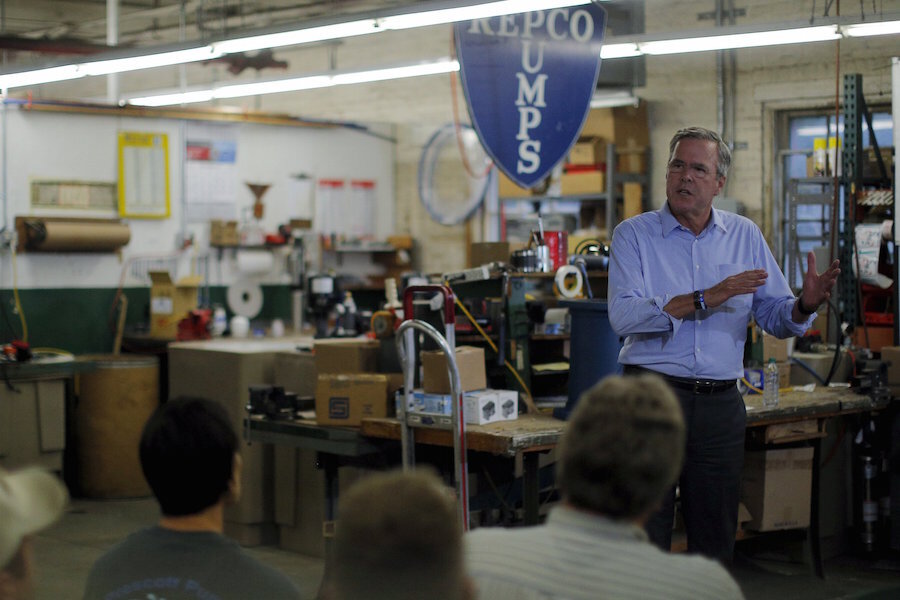Jeb Bush gets high marks for transparency
Loading...
At first glance, GOP presidential hopeful Jeb Bush’s tax reform plan is a standard lower-the-rates, broaden-the-base overhaul of the revenue code. But a closer look shows a something-for-everyone stew filled with interesting ingredients—most basic GOP fare but seasoned with a few surprising ideas.
Bush, like fellow Floridian Marco Rubio, gets credit for putting out a serious and relatively specific plan. No gauzy promises of closing “loopholes” here. Rather, Bush has filled in many important details. It isn’t a 1,000-page bill but it gives voters plenty to chew over. For a campaign document, it is remarkably transparent.
It does not answer two big questions, however. Curiously, Bush never quite says whether he intends for his plan to cut taxes or raise the same amount of money as the current code. And he never really says whether his plan would maintain the progressivity of today’s law. While a background document released by the campaign shows how taxpayers of different incomes would fare, you should look carefully at his analysis. It picks and chooses specific examples, and looks only at non-itemizers, which excludes most high-income households.
My guess is that Bush’s proposal would cut taxes substantially and that the biggest beneficiaries would be low-income households (many of whom would drop off the income tax rolls) and the highest income taxpayers who’d enjoy most benefits of the across-the-board individual rate reductions, the business tax cuts, and repeal of the Alternative Minimum Tax and the estate tax. It is less clear how middle-income households would fare.
Bush promotes his plan as part of a package that would boost economic growth to a steady 4 percent –a-year. That’s implausible, given history and demographics. But this is a presidential campaign, after all.
On the individual side, Bush would collapse the current seven rates (with a top rate of 39.6 percent) to three rates, 28-25-10. He’d not only repeal the AMT and the estate tax but he’d (mostly) eliminate the marriage penalty and end the employee share of Social Security taxes for workers older than 67. He’d also dump the existing limits on itemized deductions (known as the Pease law) and personal exemptions (aka PEP) that hit high-income households while adding new limits on those tax preferences.
Bush would take millions of low-income households off the income tax rolls, mostly by increasing the standard deduction from today’s $12,600 to $22,600 for married couples and from $6,300 to $11,300 for singles and increasing the Earned Income Tax Credit for adults with no children.
Investors would pay a 20 percent rate on capital gains. However, he’d eliminate “step-up basis” for the largest estates so that when heirs sell bequests their capital gains would be based on original cost, not value at the time of death (an idea his brother also proposed in 2001). And, he’d tax carried interest at ordinary rates.
He’d pay for some of his generous tax cuts by eliminating the deduction for state and local taxes and capping the value of most other deductions at two percent of Adjusted Gross Income. Much of the revenue from this provision would come from the mortgage interest deduction. The one exception from the deduction cap: Charitable gifts, which would continue to be fully deductible up to 50 percent of AGI. The documents released todayleave another important question unresolved: Does Bush only mean to cap deductions? What about credits and exclusions? If you want to know more about this idea, take a look at this paper and this paper by my Tax Policy Center colleagues.
At the same time, Bush vows to cut the top corporate rate from 35 percent to 20 percent, while eliminating “most” business tax breaks—though he’d keep the research credit. He’d allow full expensing of investment in both equipment and structures while ending the deduction for interest costs, a big step towards a business-level consumption tax. He’d shift to a territorial tax system where the US, like most other countries, exempts its multinationals from tax on foreign-source income. However, he’d impose a one-time 8.75 percent transition tax on existing unrepatriated foreign income of US firms, payable over 10 years.
However, Bush says almost nothing about how his territorial tax plan would work and how he’d prevent multinationals from gaming the system.
Bush seems to be steering a middle course between hard-core supply siders who favor deep cuts in rates and elimination of all taxes on investment income despite the regressivity of such a model and competitors such as Rubio, who’d retain graduated rates and add some new tax benefits for low-income households. Bush’s top rate of 28 percent is higher than the supply siders want but lower than Rubio’s 35 percent.
I still want to know more about Bush’s plan. But it is a serious and credible proposal that deserves lots of further discussion.
The post Jeb Bush’s Tax Plan: High Marks for Transparency But Key Questions Remain appeared first on TaxVox.







